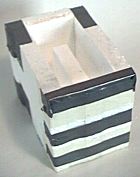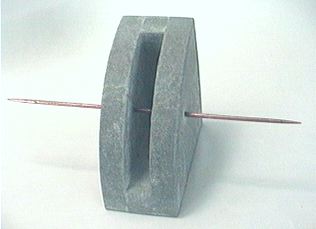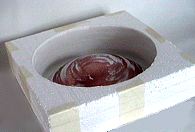Art Concrete How-to
4: Casting Concrete
THIS PAGE is one of several explaining techniques about how to use concrete in small-scale art projects.
| Book: Concrete Handbook for Artists: Technical Notes for Small-scale Objects. More information? |
You can use a variety of mixes for different purposes. A cement-sand mix (1:1 or 1:2) can be used for the basic cast shape then a cement mix with no aggregate or a very fine admixture (such as stone dust or kaolin) for patching and finishing. [See the mixes page for recent improvements to these mixes.]
 For casting these medium sized forms, I am using expanded polystyrene insulation. It can be cut roughly with a sharp knife, or accurately with a scroll saw. This method is particularly suited to simple geometric forms.
For casting these medium sized forms, I am using expanded polystyrene insulation. It can be cut roughly with a sharp knife, or accurately with a scroll saw. This method is particularly suited to simple geometric forms.
In this photograph, five layers of 1" (2.2 cm) polystyrene are sandwiched together using double-sided tape and duct tape on the outside to hold it all together. This is a one-off mold process. The mold will be broken to release the concrete.
The mix for casting should be wet enough to slump in the mold, to fill corners and spaces, but not so wet that it weakens the end result. The mix I used was:
---750 ml grey portland cement
---750 ml white sand
---40 ml polypropylene fibres (loose)
---about 300 ml latex solution (1:3, latex:water)
 This is the casting for Slot Box 3, in process, after breaking the mold and removing the polystyrene. A copper rod has been cast in place. Size: 11.5" across (29 cm) X 5" (13 cm) high. Galvanized steel or plywood are just two more of the many possible mold-making materials. The large Cast Form with Gold Leaf on a gallery page was made using galvanized sheet metal for the form.
This is the casting for Slot Box 3, in process, after breaking the mold and removing the polystyrene. A copper rod has been cast in place. Size: 11.5" across (29 cm) X 5" (13 cm) high. Galvanized steel or plywood are just two more of the many possible mold-making materials. The large Cast Form with Gold Leaf on a gallery page was made using galvanized sheet metal for the form.
 This mold for a bowl form was made from styrofoam, drywall cement to round corners, and a hand-raised copper bowl. The bowl was removed after the concrete mix set. The drywall cement was washed away.
This mold for a bowl form was made from styrofoam, drywall cement to round corners, and a hand-raised copper bowl. The bowl was removed after the concrete mix set. The drywall cement was washed away.
 These smaller jewellery pendants were cast and shaped white and grey portland cement (with fibres and latex added for strength), 2.5 inches (6.5 cm) long. They have been made into pendants (see this gallery page). They were cast in forms made from thin brass, then refined with wet sanding.
These smaller jewellery pendants were cast and shaped white and grey portland cement (with fibres and latex added for strength), 2.5 inches (6.5 cm) long. They have been made into pendants (see this gallery page). They were cast in forms made from thin brass, then refined with wet sanding.
 This is the 32" (82 cm) long mold for a piece similar to the Cast Boat Form and is made from galvanized steel held in a wood structure. I've used plastic tape to hold parts together and to give an interesting surface texture. At this point I'm using a fairly complex mix:
This is the 32" (82 cm) long mold for a piece similar to the Cast Boat Form and is made from galvanized steel held in a wood structure. I've used plastic tape to hold parts together and to give an interesting surface texture. At this point I'm using a fairly complex mix:
---4 litres portland cement
---8 litres sharp sand (brick sand, mortar sand)
---80 ml polypropylene fibres
---1 tsp (15 ml) MicroAir (air entrainer)
---4 tsp (45 ml) Pozzolith (plasticizer)
---approx. 2 litres water
This mix has been developed using information from Master Builders data sheets (see links page) for quantities of the air entrainer and plasticizer. It would be suitable for outdoor use. The amount of water is a rough estimate because of sand moisture and type. It is essential to use as little water as possible. To get the liquid additives into the mix you should add them to some (perhaps 200 ml) of the water first, add that solution to the dry mix, then continue to add straight water.
After a day the mold is broken open and the shape refined with files and emery paper. Then a small amount of coloured mix is rubbed into the textured surface:
---200 ml cement
---no sand
---2 drops MicroAir
---7 drops Pozzolith
---1.5 tsp black pigment
---latex solution (3 water:1 latex)
After another day this is sanded smooth.
[See the mixes page for recent improvements to these mixes.]
| Home | HOW-TO | Materials | Small Scale | Mesh | Casting | Colour | Hazards | Books | Sources | Shapecrete |
CONTACT + LEGAL
Last update: 2016.